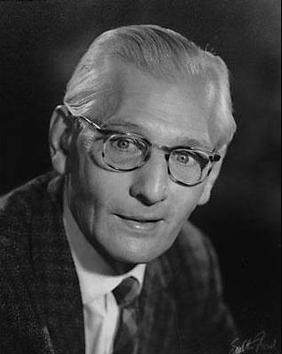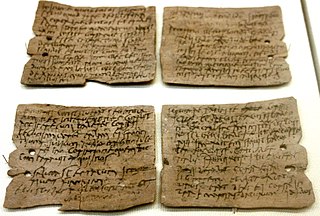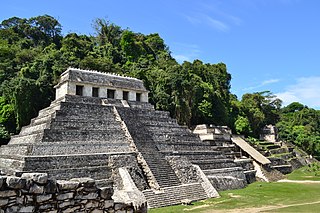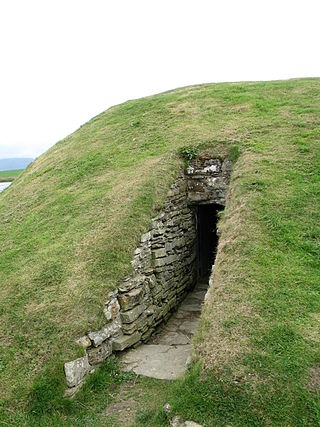Related Research Articles

Vindolanda was a Roman auxiliary fort (castrum) just south of Hadrian's Wall in northern England, which it pre-dated. Archaeological excavations of the site show it was under Roman occupation from roughly 85 AD to 370 AD. Located near the modern village of Bardon Mill in Northumberland, it guarded the Stanegate, the Roman road from the River Tyne to the Solway Firth. It is noted for the Vindolanda tablets, a set of wooden leaf-tablets that were, at the time of their discovery, the oldest surviving handwritten documents in Britain.

Palenque, also anciently known in the Itza Language as Lakamhaʼ, was a Maya city state in southern Mexico that perished in the 8th century. The Palenque ruins date from ca. 226 BC to ca. 799 AD. After its decline, it was overgrown by the jungle of cedar, mahogany, and sapodilla trees, but has since been excavated and restored. It is located near the Usumacinta River in the Mexican state of Chiapas, about 130 km south of Ciudad del Carmen, 150 meters (490 ft) above sea level. It is adjacent to the modern town of Palenque, Chiapas. It averages a humid 26°C (79°F) with roughly 2,160 millimeters (85 in) of rain a year.

Jacquetta Hawkes was an English archaeologist and writer. She was the first woman to study the Archaeology & Anthropology degree course at the University of Cambridge. A specialist in prehistoric archaeology, she excavated Neanderthal remains at the Palaeolithic site of Mount Carmel with Yusra and Dorothy Garrod. She was a representative for the UK at UNESCO, and was curator of the "People of Britain" pavilion at the Festival of Britain.

Kʼinich Janaab Pakal I, also known as Pacal or Pacal the Great, was ajaw of the Maya city-state of Palenque in the Late Classic period of pre-Columbian Mesoamerican chronology. He acceded to the throne in July 615 and ruled until his death. Pakal reigned 68 years—the fifth-longest verified regnal period of any sovereign monarch in history, the longest in world history for more than a millennium, and still the longest of any residing monarch in the history of the Americas. During his reign, Pakal was responsible for the construction or extension of some of Palenque's most notable surviving inscriptions and monumental architecture. Pakal is perhaps best known in popular culture for his depiction on the carved lid of his sarcophagus, which has become the subject of pseudoarchaeological speculations.

Anshan modern Tall-e Malyan, also Tall-i Malyan, was an Elamite and ancient Persian city. It was located in the Zagros Mountains in southwestern Iran, approximately 46 kilometres (29 mi) north of Shiraz and 43 kilometres (27 mi) west of Persepolis in the Beyza/Ramjerd plain, in the province of Fars.

Charles Francis Christopher Hawkes, FBA, FSA was an English archaeologist specialising in European prehistory. He was Professor of European Archaeology at the University of Oxford from 1946 to 1972.
The year 1999 in archaeology involved some significant events.
The year 1972 in archaeology involved some significant events.
The year 1976 in archaeology involved some significant events.
The year 1961 in archaeology involved some significant events.
The year 1964 in archaeology involved some significant events.

Alberto Ruz Lhuillier was a Mexican archaeologist. He specialized in pre-Columbian Mesoamerican archaeology and is well known for leading the National Institute of Anthropology and History (INAH) excavations at the Maya site of Palenque, where he found the tomb of the Maya ruler, Pakal. Ruz Lhuillier is sometimes referred to as the "Hitchcock of Archaeology".
The year 1979 in archaeology involved some significant events.

The Vindolanda tablets were, at the time of their discovery, the oldest surviving handwritten documents in Britain. They are a rich source of information about life on the northern frontier of Roman Britain. Written on fragments of thin, postcard-sized wooden leaf-tablets with carbon-based ink, the tablets date to the 1st and 2nd centuries AD. Although similar records on papyrus were known from elsewhere in the Roman Empire, wooden tablets with ink text had not been recovered until 1973, when archaeologist Robin Birley, his attention being drawn by student excavator Keith Liddell, discovered some at the site of Vindolanda, a Roman fort in northern England.

The Temple of the Inscriptions is the largest Mesoamerican stepped pyramid structure at the pre-Columbian Maya civilization site of Palenque, located in the modern-day state of Chiapas, Mexico. The structure was specifically built as the funerary monument for K'inich Janaab' Pakal, ajaw or ruler of Palenque in the 7th century, whose reign over the polity lasted almost 70 years. Construction of this monument commenced in the last decade of his life, and was completed by his son and successor K'inich Kan B'alam II. Within Palenque, the Temple of the Inscriptions is located in an area known as the Temple of the Inscriptions’ Court and stands at a right angle to the Southeast of the Palace. The Temple of the Inscriptions has been significant in the study of the ancient Maya, owing to the extraordinary sample of hieroglyphic text found on the Inscription Tablets, the impressive sculptural panels on the piers of the building, and the finds inside the tomb of Pakal.

Unstan is a Neolithic chambered cairn located about 2 mi (3 km) north-east of Stromness on Mainland, Orkney, Scotland. The tomb was built on a promontory that extends into the Loch of Stenness near the settlement of Howe. Unstan is notable as an atypical hybrid of the two main types of chambered cairn found in Orkney, and as the location of the first discovery of a type of pottery that now bears the name of the tomb. The site is in the care of Historic Environment Scotland as a scheduled monument.

The Temple of the Cross Complex is a complex of temples at the Maya site of Palenque in the state of Chiapas in Mexico. It is located in the south-east corner of the site and consists of three main structures: the Temple of the Cross, Temple of the Sun, and the Temple of the Foliated Cross. The Temple of the Cross is the largest and most significant. The temple is a step pyramid containing bas-relief carvings inside. The temple was constructed to commemorate the rise of Chan Bahlum II to the throne after the death of Pacal the Great. The bas-relief carvings reveal Chan Bahlum receiving the great gift from his predecessor. The cross motif found at the complex allude to the names given to the temples, but in reality the cross is a representation to the World Tree that can be found in the center of the world according to Mayan mythology.

Sonia Chadwick Hawkes, was a leading specialist in early Anglo-Saxon archaeology, described by fellow medieval archaeologist Paul Ashbee as a "discerning systematiser of the great array of Anglo-Saxon grave furnishings". She led major excavations on Anglo-Saxon cemeteries at Finglesham in Kent and Worthy Park in Hampshire.
This page lists major events of 2020 in archaeology.
This page lists significant events of 2022 in archaeology.
References
- ↑ Caubergs, M. (1997). "Les moulins souterrains du Col-des-Roches". Bulletin d'information trimestriel Groupe de recherches souterraines en milieu artificiel. 26: 3–10.
- ↑ "Archaeologists hope to discover more Roman writing tablets at Vindolanda Roman Fort | Culture24". www.culture24.org.uk. Retrieved 5 June 2017.
- ↑ St Joseph, J.K. (1974). "Air reconnaissance : recent results, 35". Antiquity. 48 (191): 213–215. doi: 10.1017/S0003598X00057999 . S2CID 163526972.
- ↑ Hawkes, Sonia Chadwick (1976). "Interim Report by Mrs. S. C. Hawkes, MA., F.SA., on the Excavations at Eastry". Archaeologia Cantiana. 92: 247–248.
- ↑ Marchant, Jo (2013). The Shadow King. Da Capo Press. ISBN 978-0-306-82134-9.
- ↑ "Protected Wrecks". Historic England. Retrieved 5 June 2017.
- ↑ "The Lost City of Anshan". Science News . 103 (14): 220–221. 1973-04-07. doi:10.2307/3957995. ISSN 0036-8423. JSTOR 3957995.
- ↑ Rybczynski, Witold (5 July 1992). "We Are What We Throw Away". The New York Times. Retrieved 5 June 2017.